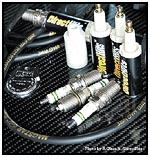 DirectHits, A Real World Test with Bill Johnston
DirectHits, A Real World Test with Bill Johnston
 Have you ever seen a late night commercial for an automotive product that was supposed to give you something for nothing? Maybe something you stuck in the air inlet to re-engineer the air flow, or something you stuck on the fuel line to realign the molecules? Install this revolutionary product and improve performance and fuel economy. Thats what I thought when I first saw the DirectHits system that was sent to us by Roadless Gear. But first impressions (evidently) arent always what they seem
Have you ever seen a late night commercial for an automotive product that was supposed to give you something for nothing? Maybe something you stuck in the air inlet to re-engineer the air flow, or something you stuck on the fuel line to realign the molecules? Install this revolutionary product and improve performance and fuel economy. Thats what I thought when I first saw the DirectHits system that was sent to us by Roadless Gear. But first impressions (evidently) arent always what they seem
The Components
 The DirectHits system includes a new set of Magstar Gold plug wires, solid zero resistance center conductor plugs and a set of DirectHits spark amplifiers. For installation there is also a package of silicone dielectric grease and a plastic twelve point socket.
The DirectHits system includes a new set of Magstar Gold plug wires, solid zero resistance center conductor plugs and a set of DirectHits spark amplifiers. For installation there is also a package of silicone dielectric grease and a plastic twelve point socket.
Installation is pretty straight forward, but it all starts with disconnecting the negative battery terminal. Sounds like we have gone a little too safety minded eh? Never pulled the power just to replace the plugs and wires? Me neither, but the reasoning is sound. In this case, the new DirectHits system is going to produce lower HC and O2 levels, which means you need to power down the computer (resetting it) so it can adjust to the new output.
 The plugs and wires are replaced just like normal. The plug gap stays the same as stock and so does the OE torque specs. But thats where it ends. Remember the little cap that screws on to the end of a spark plug? Here is where you leave the cap off and screw on the DirectHits amplifier!
The plugs and wires are replaced just like normal. The plug gap stays the same as stock and so does the OE torque specs. But thats where it ends. Remember the little cap that screws on to the end of a spark plug? Here is where you leave the cap off and screw on the DirectHits amplifier!


 The DirectHits amplifier is installed on each of the plugs using the plastic twelve point socket. This device will keep you from putting too much torque on the amplifier. You only tighten it hand tight. The plug wire then plugs onto the amplifier as it would a normal spark plug. Connect the negative battery cable again and you are ready to go.
The DirectHits amplifier is installed on each of the plugs using the plastic twelve point socket. This device will keep you from putting too much torque on the amplifier. You only tighten it hand tight. The plug wire then plugs onto the amplifier as it would a normal spark plug. Connect the negative battery cable again and you are ready to go.
The Numbers
 When you first drive the vehicle after the upgrade, it doesnt seem like much of a difference, but when you start to gather the numbers it is evident that fuel economy and performance has improved. We tested the DirectHits system on three different engine configurations, including both carbureted and fuel injected models. We did this so that we could cover the most common powerplants Samurai owners are using today.
When you first drive the vehicle after the upgrade, it doesnt seem like much of a difference, but when you start to gather the numbers it is evident that fuel economy and performance has improved. We tested the DirectHits system on three different engine configurations, including both carbureted and fuel injected models. We did this so that we could cover the most common powerplants Samurai owners are using today.
Vehicle 1
Engine
Aspiration Method
1988.5 Samurai
1.3ltr
Carbureted
Vehicle 2
1991 Samurai
1.3ltr
Electronic Fuel Injection (EFI)
Vehicle 3
1992 Samurai
1.6ltr 8valve
Electronic Fuel Injection (EFI)
These are not new vehicles, they are well used vehicles that have seen their share of use and abuse so we didnt bother with factory numbers. We assessed all three of these vehicles over a thirty day period to establish a baseline on fuel economy and acceleration on a flat, measured distance. We then installed the DirectHits system on each vehicle for a thirty day period to find an average that could be compared to the baseline numbers. This (we hoped) would show the level of improvement using the new components.
Baseline Numbers
Vehicle 1
Vehicle 2
Vehicle 3
Average MPG (89.7 Octane)
24.3 MPG
26.2 MPG
23.8 MPG
Average 0-60MPH (standing start)
52.3 seconds
43.6 seconds
38.7 seconds
With DirectHits
Vehicle 1
Vehicle 2
Vehicle 3
Average MPG (89.7 Octane)
26.8 MPG
27.9 MPG
27.2 MPG
Average 0-60MPH (standing start)
47.6 seconds
40.1 seconds
35.4 seconds
In Summary
The data shows that the installation of the DirectHits system did improve both fuel economy and power. The vehicles tested were not strictly factory stock (some upgraded more than others), so your mileage may vary. The DirectHits system does indeed do what they say and improve performance.
Source:
Roadless Gear 1-888-ROADLESS (1-888-762-3537)sales@roadlessgear.com
08/11/10 15:17:59